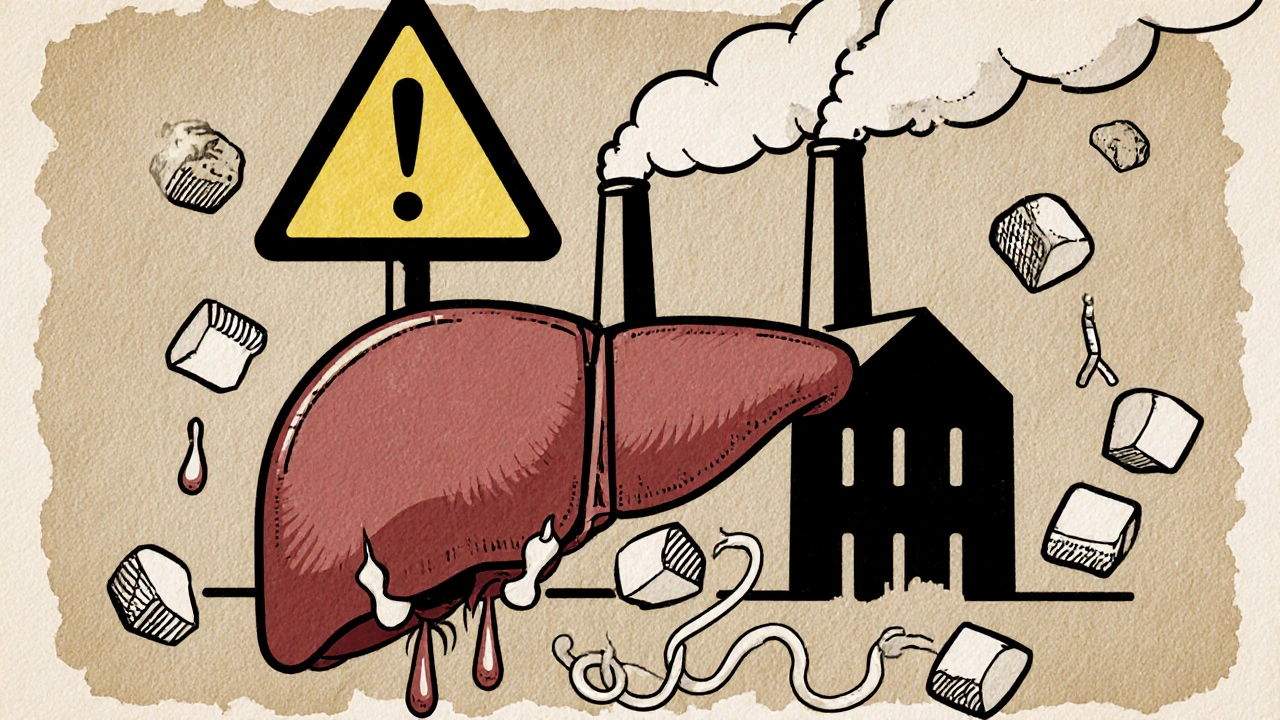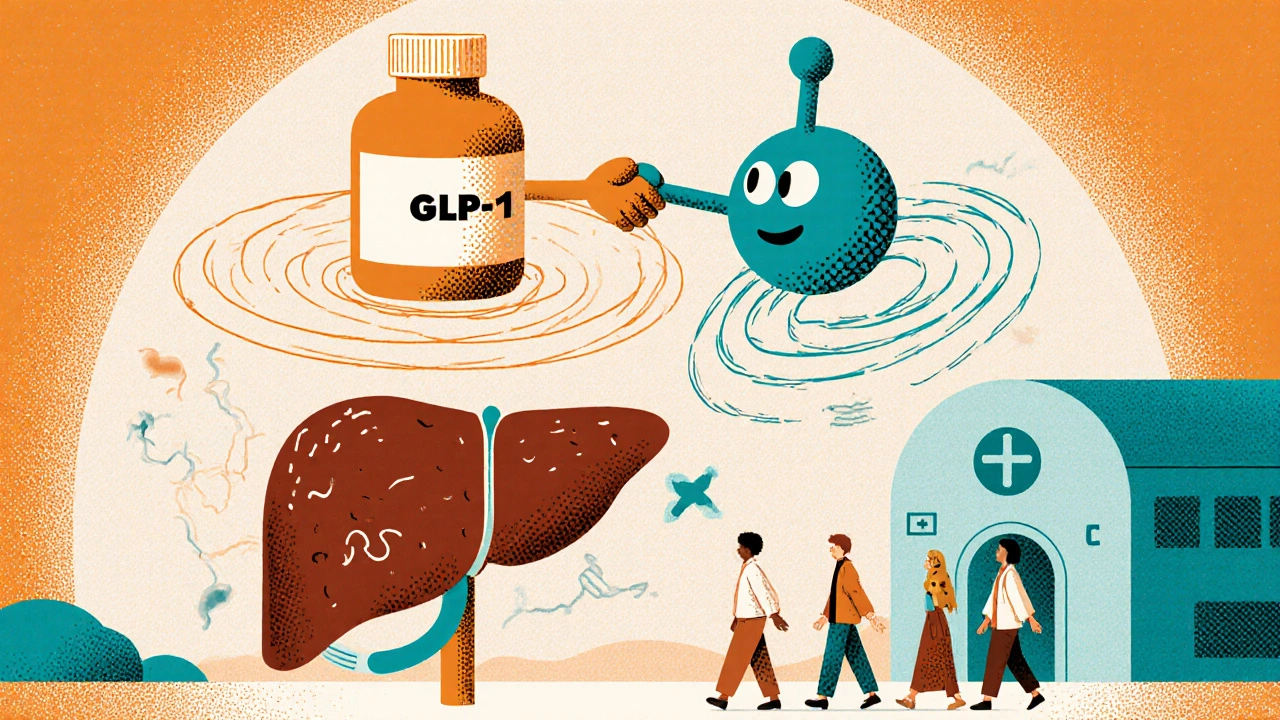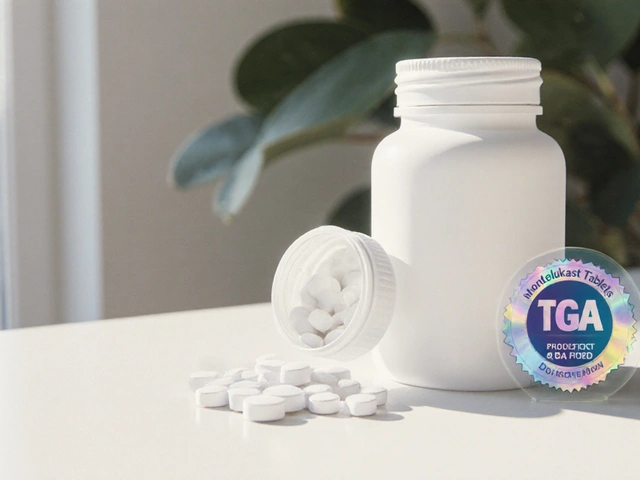
When your liver starts storing too much fat, it’s not just about being overweight-it’s a metabolic problem. Metabolic-Associated Fatty Liver Disease, now called MASLD, affects nearly 1 in 3 adults worldwide. Unlike old-school NAFLD, which was diagnosed by what it wasn’t, MASLD is diagnosed by what it is: fat in the liver plus at least one metabolic issue like obesity, type 2 diabetes, high blood pressure, or abnormal cholesterol. This isn’t just a side effect of poor diet-it’s a sign your body’s energy system is broken.
Why Fat Builds Up in Your Liver
Your liver doesn’t make fat because you eat too much butter. It’s more complex. About 59% of the fat in your liver comes from free fatty acids leaking out of your belly fat. When insulin resistance kicks in, your fat cells don’t hold onto fat the way they should. Instead, they dump fatty acids straight into your bloodstream. Your liver, already overwhelmed, takes them in and turns them into triglycerides. Another 26% comes from sugar-especially fructose-being turned into fat inside the liver itself. The rest comes from your diet. Meanwhile, your liver’s ability to burn fat for energy drops, and its ability to ship fat out slows down too. This perfect storm leads to steatosis-fat buildup that can turn into inflammation, scarring, and even liver cancer if left unchecked.Weight Loss Isn’t Just a Goal-It’s Medicine
Losing weight isn’t a suggestion for MASLD; it’s the most effective treatment we have. Losing 5% to 7% of your body weight reduces liver fat noticeably. But if you want to reverse inflammation and even start healing scar tissue, you need to hit 10% or more. The Look AHEAD trial showed people who lost 10% of their weight cut their risk of developing the more dangerous form, MASH, by 90%. That’s not luck-it’s biology. When you lose weight, your fat cells become more sensitive to insulin. That means fewer fatty acids flood into your liver. Your liver also cuts back on making new fat by 25% to 35%, and starts burning the fat it already has more efficiently.How GLP-1 Drugs Change the Game
GLP-1 receptor agonists like semaglutide (Wegovy, Ozempic) and liraglutide (Saxenda) were originally designed for diabetes. But their side effect-weight loss-turned out to be their biggest benefit for liver health. In the STEP-1 trial, people on semaglutide lost an average of 15% of their body weight. In follow-up scans, 55% of them saw their liver fat cut in half. Liraglutide helped 39% of MASLD patients reverse MASH, compared to just 17% on placebo. These drugs don’t just make you eat less. They improve insulin sensitivity in fat tissue, reduce fatty acid release by 25-30%, and directly block fat-making pathways in the liver. They also lower inflammation by calming down NF-κB, a key signal that triggers liver damage.
Real Results, Real Challenges
The numbers look great, but real life isn’t a clinical trial. On patient forums, 76% of people using semaglutide report nausea-some mild, some severe enough to quit. About one in three stop the medication within six months. And even if you lose weight, keeping it off is hard. In one survey, 42% of people regained over half their lost weight within two years. But here’s the twist: when GLP-1 drugs are paired with structured diet coaching, adherence jumps from 42% to 65%. One patient on HealthUnlocked lost 12.3% of his weight over nine months and saw his liver fat score drop from 328 to 245 on a FibroScan. That’s not just a number-it’s a healthier liver.What Works Best Together
The best outcomes come from combining lifestyle changes with medication. Experts now recommend a 12-month plan: start with a dietitian who focuses on the Mediterranean pattern-low in added sugar, especially fructose-and aim for 150 to 300 minutes of moderate exercise weekly. If you’re not hitting 10% weight loss after six months, adding a GLP-1 agonist makes sense. The Duke MASLD Clinic protocol starts with a FibroScan and MRI to measure fat and stiffness before treatment. Then they titrate the drug slowly, from 0.25 mg up to the target dose over 16 to 20 weeks. For nausea, some patients get pyridoxine (vitamin B6) at 25 mg twice daily-helpful for 65% of them. Meal replacement programs boost diet adherence to 78%, compared to just 52% with standard advice.
What’s Coming Next
The field is moving fast. The FDA now accepts liver fat measurements from MRI and FibroScan as official trial endpoints, which speeds up drug approval. Resmetirom, a new drug targeting liver metabolism, got FDA review in late 2023 and could be approved by early 2024. It’s not a weight-loss drug, but it directly reduces liver scarring. That means future treatment might combine GLP-1 drugs for fat loss and inflammation with resmetirom for fibrosis. Meanwhile, tirzepatide (Mounjaro), which works on both GLP-1 and GIP receptors, is showing even better weight loss results than semaglutide in trials. The global MASLD drug market is expected to hit $28.7 billion by 2030. But access is uneven-only 28% of rural U.S. counties have a specialist. And while insurance covers GLP-1 drugs for diabetes, coverage for obesity and liver disease varies widely.Where You Stand Today
If you’ve been told you have fatty liver, you’re not alone. But you’re not powerless. The path forward isn’t about extreme diets or miracle pills. It’s about consistent, manageable changes. Start by losing 5% of your weight-maybe by cutting sugary drinks, walking 30 minutes a day, or swapping processed snacks for nuts and fruit. If that’s not enough after six months, talk to your doctor about GLP-1 therapy. Don’t expect perfection. Side effects happen. Weight comes back. But every 1% of weight lost improves your liver. Every week you stick with it reduces your risk of cirrhosis. This isn’t a quick fix-it’s a long-term reset of your metabolism. And with the right tools, it’s one you can sustain.Can you reverse MASLD without medication?
Yes, but only if you lose enough weight. Losing 5-7% of your body weight improves liver fat. To reverse inflammation and early scarring, you need to lose 10% or more. Studies show that 45% of people who hit this target see MASH resolve completely. Lifestyle changes-diet, exercise, sleep-are the foundation. Medication helps when lifestyle alone isn’t enough.
How much weight loss is needed to see liver improvement?
A 5-7% weight loss reduces liver fat significantly. For inflammation and fibrosis to improve, you need at least 10%. The Look AHEAD trial found that people who lost 10% had a 90% lower chance of developing MASH. In clinical trials, those who lost 10% or more saw up to 45% resolution of MASH. It’s not linear-the bigger the loss, the better the liver response.
Do GLP-1 drugs work for advanced liver scarring?
Not as well. GLP-1 drugs are great at reducing fat and inflammation, but they have limited effect on advanced fibrosis (stage F3-F4). If you have significant scarring, combining GLP-1 therapy with drugs like resmetirom-targeted at fibrosis-may be necessary. Experts now recommend checking fibrosis levels with FibroScan or MRI before deciding on treatment.
Are GLP-1 drugs covered by insurance for fatty liver?
Coverage depends on the drug and your plan. Semaglutide and liraglutide are FDA-approved for obesity and type 2 diabetes, so many insurance plans cover them for those uses. But coverage for fatty liver specifically is not guaranteed. Medicare Part D covers about 67% of beneficiaries for obesity, but private insurers vary. Always check with your provider and ask for prior authorization using the obesity or diabetes diagnosis code.
What are the most common side effects of GLP-1 drugs?
Nausea is the most common, affecting up to 76% of users. Other side effects include vomiting, diarrhea, constipation, and reduced appetite. About 30-40% of people stop the medication within six months due to GI discomfort. Starting low and increasing slowly helps. Some patients find relief with vitamin B6 (pyridoxine) at 25 mg twice daily. Rare risks include pancreatitis and gallbladder disease, but these affect less than 1% of users.
How long do you need to stay on GLP-1 drugs for MASLD?
There’s no set end date. MASLD is a chronic condition tied to metabolism. Stopping the drug often leads to weight regain and return of liver fat. Experts recommend continuing therapy as long as it’s helping and tolerated. Think of it like blood pressure or diabetes medication-treatment may be long-term. The goal is to use it as a tool to reach sustainable lifestyle changes, then reassess with your doctor.
Can you use GLP-1 drugs if you don’t have diabetes?
Yes. Semaglutide (Wegovy) and liraglutide (Saxenda) are approved for chronic weight management in adults with obesity or overweight with at least one weight-related condition-including MASLD-even without diabetes. You don’t need to be diabetic to qualify. Your doctor will assess your BMI, liver health, and metabolic risk factors to determine eligibility.




farhiya jama
November 27, 2025 AT 14:23Ugh, I tried Wegovy for 3 months. Nausea so bad I cried at work. Then I gained back everything plus my ex’s old hoodie. Why does everyone act like this is magic? It’s just expensive vomiting pills with a fancy name.
Astro Service
November 29, 2025 AT 06:15Why are we letting big pharma sell us pills instead of just telling people to stop eating junk? In my day, we just ate less and walked more. No drugs needed. This is why America’s broken.
DENIS GOLD
November 29, 2025 AT 09:43Oh wow, another ‘GLP-1 miracle’ article. Next they’ll tell us coffee cures cancer. 15% weight loss? Cool. Now tell me how many people died from pancreatitis while trying to look like a supermodel on a $1200/month drug. 🤡
Ifeoma Ezeokoli
November 30, 2025 AT 10:15Y’all are so focused on the pills and the numbers, but what about the *feeling*? I lost 14% with diet and walking my dog every morning. No drugs. Just me, my shoes, and the sunrise. It’s not about perfection-it’s about showing up for yourself, even when it’s hard. 💛
Daniel Rod
November 30, 2025 AT 23:15It’s wild how we treat our bodies like machines that need firmware updates. But we’re not code-we’re living, breathing, emotional beings. The real fix isn’t just losing weight… it’s learning to stop punishing ourselves for existing. 🌱
gina rodriguez
December 1, 2025 AT 21:16I started with cutting soda and walking 20 mins a day. Lost 6% in 3 months. Felt lighter-not just physically. If you’re overwhelmed, start small. You don’t need a miracle. Just consistency.
Sue Barnes
December 2, 2025 AT 21:20Anyone who thinks they can fix fatty liver with ‘lifestyle changes’ is delusional. You need the drug. Period. If you’re too lazy to take a shot, don’t blame the medicine. Your liver doesn’t care about your excuses.
jobin joshua
December 4, 2025 AT 12:58Bro I took semaglutide and lost 18% but now I'm broke and my stomach hates me. But hey at least my liver is happy 😅
Sachin Agnihotri
December 5, 2025 AT 01:07Wait-so if you lose 10%, MASH resolves in 45% of cases? That’s huge. But why do we keep acting like this is a ‘choice’? My cousin has MASLD, works two jobs, eats cheap food, sleeps 4 hours. It’s not willpower-it’s systemic.
Diana Askew
December 5, 2025 AT 18:37GLP-1 drugs are a government plot to make us dependent on Big Pharma while they hide the real cure: magnesium and sunshine. They don’t want you healthy-they want you on a monthly subscription. 🕵️♀️
King Property
December 6, 2025 AT 21:36You people are missing the point. The real issue is insulin resistance, not fat. And yes, GLP-1 drugs help-but so does intermittent fasting, cold showers, and stopping eating after 7pm. I’ve studied this for 12 years. You’re all just repeating what Big Pharma tells you to say.
Yash Hemrajani
December 8, 2025 AT 05:08Oh wow, so the ‘miracle drug’ works better than diet? Shocking. Next you’ll tell me water hydrates you. 😒
Pawittar Singh
December 10, 2025 AT 01:20You got this. I was where you are-overwhelmed, tired, scared. But I started with one apple a day. Then added a walk. Then talked to my doc about meds. Progress > perfection. You’re not failing-you’re learning. 🙌💪
Josh Evans
December 11, 2025 AT 02:43I’ve been on semaglutide for 8 months. Nausea was bad at first but B6 helped. Lost 16%. My FibroScan dropped from 380 to 190. It’s not perfect but it’s working. Keep going.
Allison Reed
December 11, 2025 AT 19:46Every 1% of weight loss reduces liver fat. That’s powerful. Don’t wait for 10% to feel progress. Celebrate the small wins-they add up.
Jacob Keil
December 12, 2025 AT 06:05So the real problem is capitalism? And we’re just supposed to take pills while the rich get richer? I mean… I guess. But what if we just stopped eating sugar? Would that be too hard? 🤔